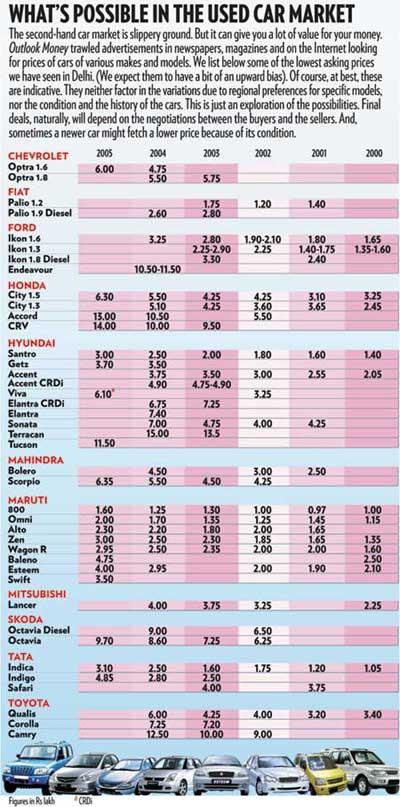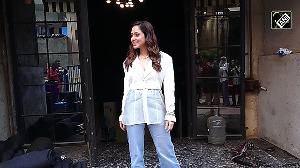For about Rs 2 lakh, you can get for a 2002 model Ford Ikon 1.6, a Wagon R, or Santro. . .
"Would you buy a used car from this man?" screamed the tagline of a poster with a scowling Richard Nixon before the 1960 US presidential elections.
The implication: this man is as trustworthy as a used car salesman. In other words, not at all.
That one poster used by the Democrats, say political pundits, swung the crucial votes for Democratic Party candidate John F. Kennedy and won him one of the closest races to the White House.
Pothole watch
In the half-a-century or so that has elapsed since then, the perception of the second-hand car salesman has changed little. Cars of the same make and model can become very different from each other after, say, three years on the road.
That's because no two of them are used in exactly the same way and, therefore, wear differently.
The seller is aware of exactly what a car has gone through, but not the buyer. So, for the latter, the problem is to value the car with little and, often, incorrect information to go on.
Younger and fitter
From that perspective, buying a used car is a daunting task, but the scenario is getting better for India's second-hand car buyer. Today, this market has grown to an estimated at 8,00,000-1 million cars a year, says Vinay Sanghi, CEO, automartindia. That's a little smaller than the new car market.
Till not too long ago, people considered it an achievement to buy one car in a lifetime and, therefore, held on to it often till death parted them. Not any more. Ravi Narayanan, group business head (car and commercial vehicles), ICICI Bank, says that the average age of vehicles coming into the used car market is down to 38 months today from about 48 months even a couple of years ago.
So the amount of wear on a used vehicle today is much less than it used to be.
The quality of used cars has also improved with intense competition among manufacturers in the new car market. So, today's cars age better. Although it is possible to buy cars that are less than two years old, the end of the second year is when cars usually start coming into the second-hand market in significant numbers. At this point, today's cars have a large part of their life left. What they have lost is novelty.
Value erosion
A two-year-old car with routine maintenance makes for a good buy unless it has had a shunt or has been involved in criminal activity. A reason for that is that the bulk of the depreciation on a vehicle happens during its first two years.
The day a vehicle is delivered, its value can fall up to 20 per cent. Another 10-15 per cent goes in Year One. The second year clips another 10-15 per cent off the purchase price. Therefore, at the end of two years, the value of a vehicle is down by 30-40 per cent. But a car would have lived only 20-25 per cent of its life.
After the second year, the value keeps falling by 10-15 per cent each year. By the end of the fifth year, says Narayanan, the price of the smaller, utilitarian vehicles is around half of what was paid for it; bigger cars, with exceptions, retain only about 35-40 per cent of their value.
If a vehicle costs Rs 100 new, it can be bought for Rs 60-65 at the end of Year 2 and sold for Rs 40-50 at the end of Year 5. So the depreciation hit a buyer has to take is significantly lower if, rather than a new car, he buys a two-year-old and sells it after three years. The depreciation tapers off after the fifth year, adds Narayanan.
A matter of size
Price parity. If you want your costs to go even lower, you can go for a five-year-old car. After depreciation, at this vintage, prices of two cars that cost Rs 4 lakh and Rs 6 lakh new would not be too different in the used car market.
In Delhi, for example, Rs 2 lakh will get you a Hyundai Santro or a Maruti Wagon R from 2002. For about Rs 25,000 more, you can buy a Ford Ikon 1.6 from the same year.
Shell out another Rs 25,000 and a Mitsubishi Lancer from 2001 or 2002 could be yours. A lakh or so more, and you could take home a Hyundai Sonata from 2001 that cost over Rs 10 lakh when new.
While these cars sell at prices close to each other's in the used car market, they were originally meant for very different customers. If you bought a sedan, your expectations from it would have been much higher than if you had purchased a hatchback runabout. So, bigger cars tend to be better built and hold up better after, say, five years of use.
Consequently, with the narrowing of the price gap, they make better buys.
Choice set. Ravi G. Bhatia, who heads Maruti Udyog's True Value used car business, says: "We have seen that some people prefer used cars as they want to go for a bigger car in the same budget as a new small car."

In fact, the used car market widens the choice of models for a car buyer on a budget, who would otherwise be restricted to buying econoboxes.
Dhruv Behl, editor of AutoXchange, a magazine exclusively for used cars, says most people look for bigger cars in the second-hand market because of any or a combination of three reasons. These are greater space, the (usually) higher power that makes driving more pleasurable, and the statement a bigger car makes for its owner.
Sanghi says the profile of the buyer of premium used cars is not very different from that of a buyer looking for a new hatchback.
While five-year-old cars sound good, remember that the time to make a few replacements of expensive parts like clutch assemblies may be approaching. This will drill a bigger hole in the pocket than the routine oil change.
Safety catch. The bigger the cars, the safer they usually are in an accident as they have larger areas to absorb and distribute the shock of the impact.
The boot and engine areas of modern cars have crumple zones that collapse to take more of the shock so that less is transmitted to the passenger compartment. The less the shock transmitted, the less the extent of distortion it undergoes, and the greater the chance of survival of the passengers.
In a hatchback, at least in a rear-end impact, the passenger compartment itself has to take the shock. Also, some of the bigger cars come with features such as airbags and anti-lock brakes, which further improve matters if things go wrong.
Hunting grounds
Always drive a car before you buy it to see whether you are comfortable with it. All documents, too, should be in order, says Bhatia. Also, run checks on maintenance records to see if they tally with the odometer reading and get the car inspected by an expert. But to do all this you need to spot the car. Sanghi says that you should also stay off discontinued models.
Familiarity pays. The best used car you can probably buy is one you have seen and known. For, chances are that you would know the owner of such a car too. If so, he is less likely to be dishonest with you than a stranger.
Without a broker and commissions, the price would be less too. Be ready to wait to land yourself a car like this. Keep your eyes and ears open and some cash handy. If you know the car, you can buy it straight off when it goes up for sale, or make a part-payment and take delivery when you cobble up the rest of the cash.
Peace-of-mind deals. Next come the cars refurbished and sold by new car dealers or outfits like Maruti True Value and automartindia. The problem is that they still account for less than 10 per cent of the total market.
The cars here are usually trade-ins. Because of the checks these outfits run, you are unlikely to land up with a vehicle that will break down or will be towed away by the police. They will usually come with a warranty and free services too. But this peace of mind will come for a price.
So be ready to shell out about 10-20 per cent more than the first option.
Cautious steps. The third option is to buy directly from existing owners who you do not know. This needs some expertise and you would be better off taking an expert mechanic along to assess the car.
You would usually need to pay him Rs 100-300 for the job, but it would be money well spent. A check of the papers is a must, as well as of the car's police record. If you like the car, you could make a part-payment that should be returnable -- get it in a written agreement -- if there is a problem with the owner. Make sure you meet the owner and are satisfied about his genuineness.
Unusual sources. A lot of cars used by corporates today are owned and run by fleet leasing companies. As breakdowns would blot their record, the cars are usually well maintained. The leasing companies often sell cars that can make good buys, even if they are of higher mileage.
The same applies to company-owned cars, especially those used by higher-level officials usually sold through tenders.
Steer clear. Don't touch cars that have been in motorsport as well as those with major modifications. Both of them reduce the structural strength of a car and it can develop very irritating squeaks and rattles even if it holds up.
Local 'car bazaars' and brokers are the trickiest when it comes to buying cars. Here is where you are most likely to find doctored odometers, cars with major accident histories, and painted-over rust buckets. It's futile to pit your expertise against that of the salesmen. After all, it's their bread and butter, not yours.
Mr Walker. Before you hit the second-hand car market, you must perfect the art of walking away, however tempting the offer may be. If you don't, you would be just the one the lemons are waiting for.






 © 2025
© 2025